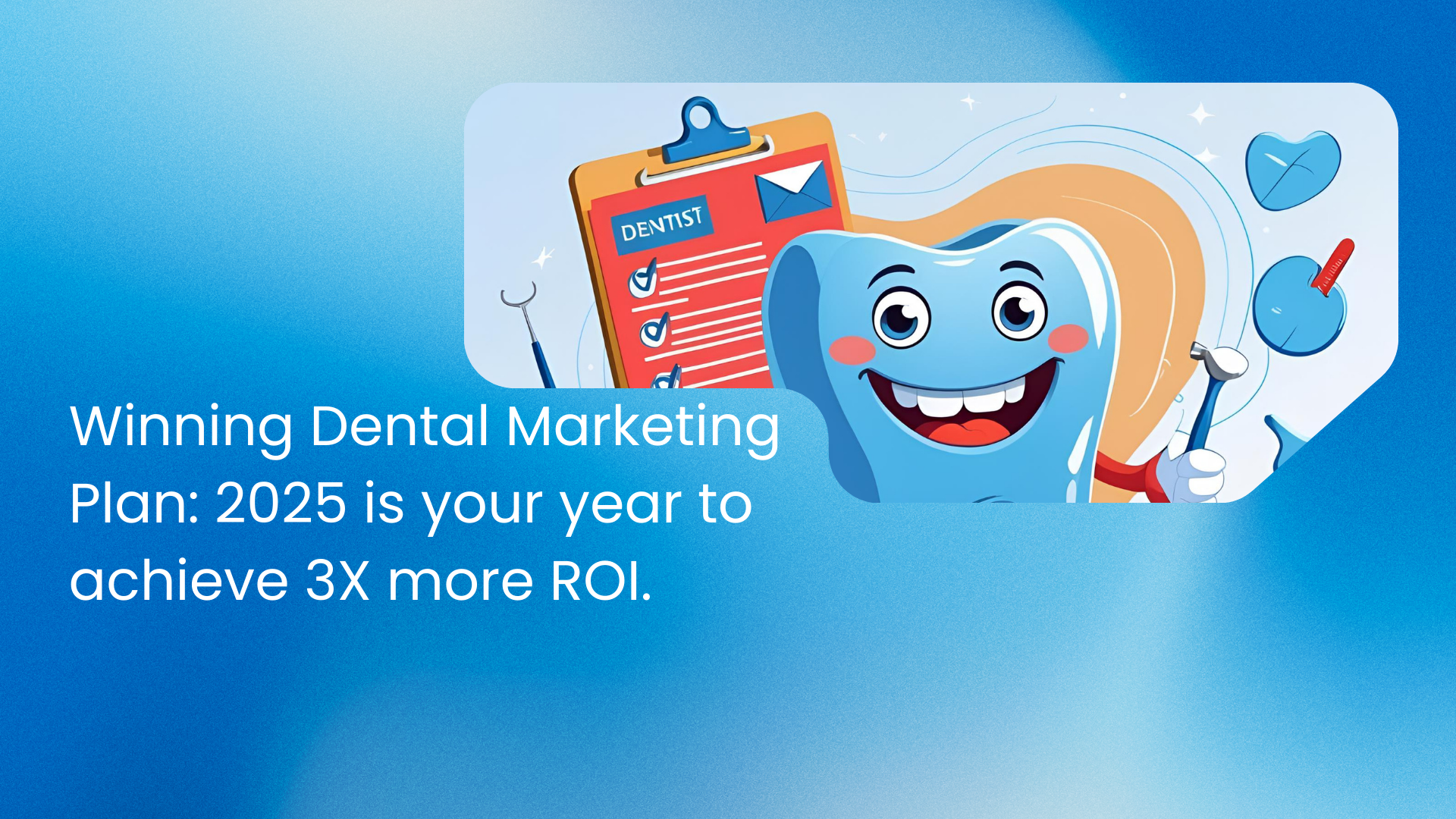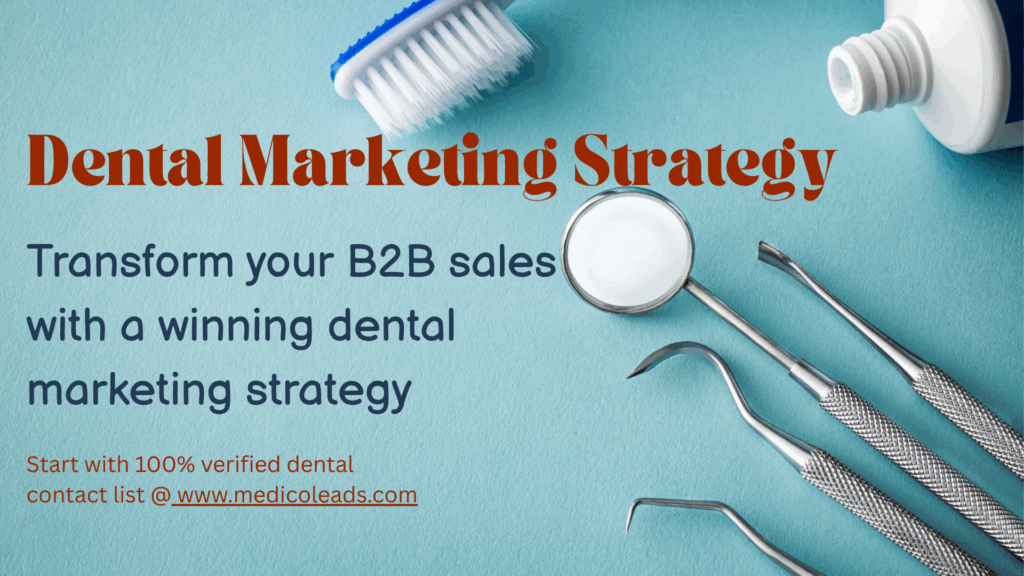It is a strategy to engage dental professionals through SEO, ads, and content.

TABLE OF CONTENTS
Dental marketing is a lucrative business, especially for B2B marketing targeting dental practices. As dental offices look to expand their reach and improve their services, they rely on external marketing experts for guidance in strategy, advertising, and technology.
B2B marketers can tap into this growing demand, offering tailored solutions to help dental professionals increase visibility, streamline their patient acquisition, and enhance brand reputation.
In this guide on dental marketing plan, we’ll explore the key strategies and insights that can empower B2B marketers to thrive in the dental industry, offering practical takeaways you can implement right away.

1. What Is a Dental Marketing Plan?
A winning dental marketing plan targets dental professionals through data-driven strategies. It includes local SEO, content marketing, and targeted ads to reach dentists. The plan also integrates industry-specific email campaigns, webinars, and referral programs to build trust and long-term partnerships.
1.1. The Purpose of a Dental Marketing Plan
The purpose a well-defined dental marketing plan includes:
- Aligning Marketing with Business Goals: Ensures your marketing strategies are directly tied to the specific goals of dental practices, whether it’s increasing customer acquisition, boosting brand awareness, or driving revenue.
- Driving Targeted Traffic and Conversions: Focuses on reaching the right audience—dentists and dental practices—through precise targeting and effective content strategies, turning leads into valuable clients.
- Building Brand Authority in the Dental Niche: Positions your marketing services as essential for dental practices by showcasing your expertise and providing value, making your brand a trusted partner in the dental industry.
For B2B marketers, aligning your efforts with these goals helps build stronger relationships with dental professionals and drives tangible results for both parties.
1.2. Who Can Benefit from a Dental Marketing Plan?
- Startups in the Dental Industry: New dental practices or businesses looking to establish a strong presence and attract their first wave of patients.
- Marketing Agencies Serving Dental Clients: Agencies working with dental professionals or related businesses to drive growth and visibility through tailored marketing strategies.
- Product Teams Launching Dental Solutions: Companies introducing new dental products or services need a strategic plan to engage dental professionals and showcase the value of their offerings.
In each case, a well-crafted dental marketing plan helps businesses connect with the right audience, build credibility, and achieve long-term growth.
2. Core Components of an Effective Dental Marketing Plan
A solid dental marketing plan is all about getting the right attention, connecting with potential patients, and growing your practice.
Here’s a quick rundown of the must-haves for a killer marketing strategy:
2.1. Know Your Audience (Market Research)
Before you dive into anything, it’s super important to understand who you’re talking to. Are you targeting general dentists, orthodontists, or dental suppliers? Check out what your competitors are doing and stay on top of trends and prospect needs. This will help you keep your marketing fresh, relevant, and spot-on.
2.2. What Makes You Different? (UVP)
What makes your dental product or service stand out? Your Unique Value Proposition (UVP) is what sets you apart in a crowded field, so make it clear! Highlight how you’re solving problems or offering something better. Make sure this message is consistent everywhere—website, social media, emails—so your brand’s value sticks.
2.3. Set Some Goals (Marketing Goals & KPIs)
It’s important to have a roadmap. Are you aiming to boost brand awareness, generate leads, or get more conversions? Use Key Performance Indicators (KPIs) like website traffic, click-through rates, or customer acquisition costs to keep track of your progress and see what’s working (or needs tweaking).
2.4. Pick the Right Channels (Channel Strategy)
Not all marketing channels are created equal. Focus on the ones that work best for reaching dental professionals. SEO and content marketing are great for organic traffic, while paid ads (think PPC or LinkedIn) help you target specific people. Don’t forget about email marketing, webinars, or influencer partnerships to keep the engagement going.
2.5. Budget Smart (Budget Allocation)
Get the most bang for your buck! A smart budget split will help you hit both short-term and long-term goals. Put around 40% into content and SEO, 30% into paid ads, 15% into tools/software, and 15% into testing and optimizing. Balance is key!
These elements are the building blocks for a solid dental marketing plan. If you nail them, you’ll be driving growth and staying ahead of the competition in no time!

3. Step-by-Step Process to Build Your Dental Marketing Plan
With the core components in mind, building your marketing plan becomes a breeze. Just follow this step-by-step guide to get started.
3.1. Step 1: Define Your Objectives
Start by aligning your marketing goals with your overall business objectives. Whether it’s boosting brand awareness, increasing conversions, or driving sales, make sure your goals are clear and measurable. This helps ensure your efforts are focused and effective.
3.2. Step 2: Identify Your Target Audience
Create detailed buyer personas to understand who you’re marketing to. Focus on:
- Demographics: Age, location, income, and other relevant factors.
- Job Roles: Are you targeting general dentists, orthodontists, or dental hygienists?
- Pain Points: What challenges do they face? Is it attracting new patients or managing appointments?
- Behavior Triggers: What motivates them to act? Is it a seasonal promotion, a new service, or a referral from a colleague?
Knowing these details will help you craft messages that truly resonate. You can also use resources like dental email and mailing list to help you refine your audience insights and ensure your marketing reaches the right people.
Ready to reach the right dental professionals with your marketing?
Explore how MedicoLeads dental contact database can help you connect with your ideal audience.
Learn More Today!3.3. Step 3: Select Marketing Channels
Choose marketing channels that make the most sense for your budget, audience, and timeline. Prioritize the ones that offer the highest return on investment (ROI) and are scalable. Start with the big hitters—like SEO, paid ads, and email marketing—before branching out to other channels.
This way, you can maximize your impact without spreading yourself too thin.
3.4. Step 4: Content Planning and Messaging
Create a content calendar to stay organized and consistent. Focus on high-intent topics and keywords that align with what your audience is searching for. Make sure your content matches the different stages of the customer journey—whether it’s awareness (TOFU), consideration (MOFU), or decision-making (BOFU).
3.5. Step 5: Launch and Monitor
Once you’re ready to launch, set up dashboards to track key metrics. Monitor:
- Traffic Sources: Where are your visitors coming from—organic search, paid ads, social media?
- Campaign Performance: Are your campaigns hitting your targets? Look at click-through rates, conversions, and engagement.
- Lead Quality: Are the leads you’re generating the right fit for your practice? Track how many convert into potential customers.
Regular monitoring helps you adjust strategies quickly and ensures you’re on the right track.
3.6. Step 6: Optimize Based on Data
Use data to fine-tune your strategy. Run A/B tests on ad copy and calls-to-action (CTAs) to see what resonates best with your audience. Based on campaign performance, adjust your budget allocations—put more into the channels that are delivering the best results and tweak or scale back on those that aren’t.
Continuous optimization helps you maximize your marketing efforts and get the best ROI.
4. Common Mistakes in Dental Marketing Plans
Even the best dental marketing strategies can fall short if they’re not executed properly. Avoid these common mistakes to ensure your plan stays on track and delivers results:
4.1. Lack of Clear Objectives
Without specific, measurable goals, it’s hard to track progress or know if your efforts are working.
4.2. Ignoring Customer Insights
Failing to understand your target audience’s needs and pain points can lead to irrelevant messaging and missed opportunities.
4.3. Spreading Too Thin Across Channels
Trying to be everywhere at once often leads to burnout and lower returns. Focus on the channels that matter most to your audience.
4.4. Not Tracking ROI Accurately
Without proper tracking, you can’t gauge the effectiveness of your campaigns. Missing this step means wasting money on what isn’t working.
4.5. Outdated Messaging or Positioning
If your messaging doesn’t reflect current trends or customer needs, you risk sounding out of touch and losing relevance in the market.
Conclusion
Building a successful dental marketing plan requires clear objectives, audience insights, and the right strategies. By focusing on targeted channels, data-driven decisions, and continuous optimization, B2B marketers can create effective campaigns that drive growth. Avoid common mistakes, and stay adaptable to ensure long-term success in the dental industry.
Boost Your Marketing Strategy with the Right Data
Make sure your dental marketing is hitting the mark. Access MedicoLeads comprehensive database of dental professionals and optimize your campaigns. Start Your Journey Here!
FAQ
How do I define my target audience for dental marketing?
Create buyer personas based on demographics, roles, and pain points.
What marketing channels are best for targeting dentists?
Utilize SEO, PPC, email marketing, and webinars to effectively reach dental professionals.
How can SEO help in a dental marketing plan?
SEO boosts visibility by optimizing content for relevant dental keywords.
What’s the role of email marketing in dental marketing?
Email nurtures leads by delivering valuable content and offers.
How do I measure success in a dental marketing plan?
Track KPIs like traffic, leads, conversions, and ROI.
Why is a Unique Value Proposition important for dental marketing?
It differentiates your offering and addresses dentists’ specific needs.
How do I optimize my dental marketing plan with data?
Use data to refine ads, budgets, and targeting based on performance.
What are common mistakes in dental marketing?
Avoid unclear goals, poor targeting, and not tracking ROI.
How can MedicoLeads help with dental marketing?
MedicoLeads provides a dental contact database for better targeting.
Contact Us

